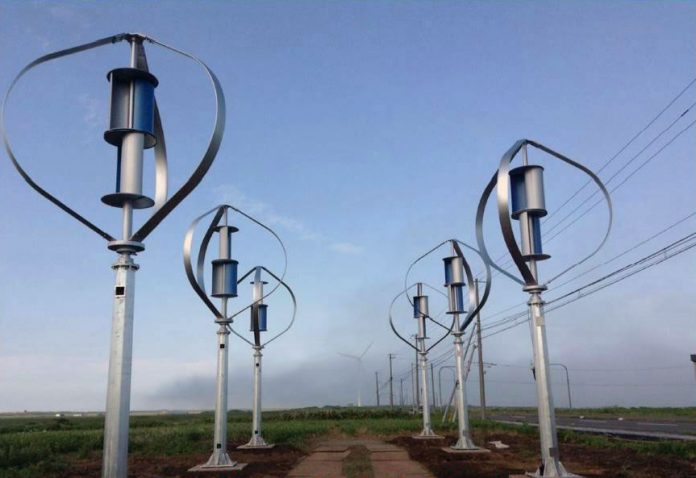Hi-VAWT’s DS3000 small wind turbine is the latest model to achieve certification under the ICC-ES Small Wind Certification Council (ICC-SWCC) Small Wind Turbine (SWT) Program. It is also the first vertical-axis wind turbine (VAWT) to complete the rigorous ICC-SWCC certification process.
Vertical-axis turbines use a unique geometry and feature distinctive vertical blades that are arranged perpendicularly through the windstream. The Hi-VAWT DS3000 turbine has been granted certification SWCC-18-02, which demonstrates compliance with the AWEA 9.1 standard that serves as the basis of the ICC-SWCC SWT program. Hi-VAWT is based in Taiwan, and is represented in the U.S. by Colite Technologies, who submitted the turbine for certification.
The DS3000 turbine’s product information, test reports and calculations were thoroughly reviewed to confirm that all requirements of the ICC-SWCC SWT program were satisfied. The DS3000 is a 3-blade, vertical axis wind turbine with a combination Darrieus-Savonius rotor with a 3.7 m in diameter. ICC-SWCC rated its annual energy production at 2,460 kWh per year* and 1.4 kW rated power at 11 m/s wind, and a rated sound level of 42.3 dB(A)**.
“The completion of the first successful VAWT certification for a small wind turbine is an exciting development for the industry and ICC-SWCC. We congratulate Hi-VAWT and its U.S. partner, Colite Technologies, for this achievement,” said ICC Evaluation Service Vice President of Technical Services Shawn Martin. “The ICC-SWCC program provides third-party performance ratings and assurance that certified turbines have passed rigorous testing and performance requirements.”
“The Hi-VAWT Technology Corporation has been offering its turbines in the United States for nearly a decade. It is now very rewarding to finally achieve an official certification from ICC-SWCC confirming the integrity of the technology,” said Kevin O’Hara, President and CEO of Colite Technologies. “The Hi-VAWT technology is not only the sole vertical access wind turbine technology to reach this level of certification in the U.S., but also across the globe. We are extremely proud and excited to be a representing Hi-VAWT in the U.S.”
ICC-SWCC SWT certification is utilized by numerous incentive programs, regulations and codes in many states and countries, including the Federal Investment Tax Credit (ITC). The ITC was reinstated in 2018 for small wind turbines, providing a significant, 30% tax credit for the costs of equipment and installation of wind turbines under 100 kW.
ICC-SWCC is a program of ICC Evaluation Service (ICC-ES), the United States’ leading evaluation and certification service for innovative building and plumbing products. Building officials, architects, contractors, specifiers, designers and incentive programs utilize ICC-SWCC certifications to provide the basis for using or approving renewable energy products.
Click HERE to view certification.
About ICC-SWCC
The Small Wind Certification Council (ICC-SWCC), a program of the ICC Evaluation Service, is accredited to certify small and medium wind turbines that meet or exceed the requirements of specified standards. Designed to promote consumer confidence and mainstream acceptance of small and medium wind technology, ICC-SWCC certification standardizes North American reporting of turbine performance.
About Colite Technologies
Colite Technologies is a company based in Columbia, South Carolina, offering distributed renewable energy power systems, renewable powered outdoor lighting, and energy efficiency upgrades for indoor and outdoor lighting systems. The company serves customers across commercial, industrial and residential markets, including public and private sectors, with its products, systems and services.
* Annual energy production rating assumes average annual wind speed of 5 m/s with a Rayleigh wind speed distribution, sea level air density and 100% availability. Actual production will vary depending on site conditions.
** Assumes the sound level will not be exceeded 95% of the time assuming the wind conditions above and observed 60 m from rotor center.



















